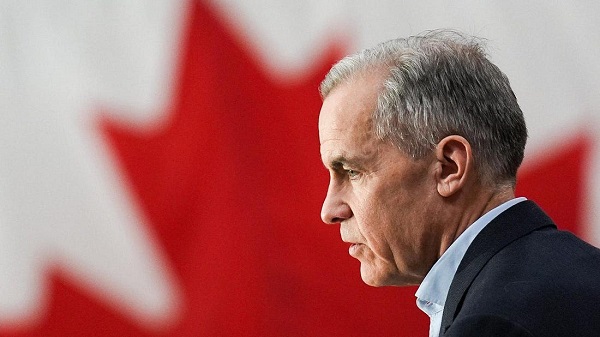Automotive
Ottawa’s EV mandate may destroy Canadian auto industry

From the Fraser Institute
No one had to force the public to abandon land lines for cellphones, or vinyl records for CDs and then online streaming. When superior products appear, people will switch voluntarily. An EV mandate may be affordable by 2035—but only if the product quality and user costs have progressed to the point that people want to switch anyway, in which case the mandate is not needed.
According to energy transition and “net zero” enthusiasts, the future looks bright for electric vehicles (EVs). So bright that the federal government and some provincial governments have had to offer some $15 billion in subsidies to prompt carmakers to develop Canadian production facilities while also offering lavish subsidies to get people to buy EVs. And since even that isn’t enough, according to a Trudeau government mandate, all new light-duty vehicles sold in Canada must be electric or plug-in hybrid by 2035. In other words, the government wants to ban traditional internal combustion engine vehicles (ICEVs).
The fundamental problem is that EVs cost more to make and operate than most consumers are willing to pay. In a 2016 submission to the Quebec government, which was then considering an EV mandate of its own, the Canadian Vehicle Manufacturing Association warned that its members were then losing between $12,000 and $20,000 per EV sold. Since then, the situation has gotten worse, with Ford reporting first quarter 2024 losses of US$132,000 per EV.
What will be the economic consequences of a national EV mandate in Canada? In a new paper forthcoming in the peer-reviewed Canadian Journal of Economics, I develop and run a detailed inter-provincial model of the Canadian economy including the auto sector. I argue that during the phase-in period the auto sector will raise the price of ICEVs and earn above-market rents on them, but that won’t cover the losses on the EV side and the industry will go into overall losses by the late-2020s. The losses will be permanent unless and until EV production costs fall enough that a mandate is unnecessary. In short, the 2035 mandate is affordable only if it’s not needed. If it takes a mandate to force consumers to choose EVs over ICEVs, the mandate will destroy the Canadian auto industry.
The mandate sets up a race between regulation and technology. Some aspects of EV production are falling, such as batteries. Others, such as specialty metals used in motors, are sole-sourced from China and are not getting cheaper. Other user costs are rising including electricity, for which we can thank two decades of green energy madness. Taking all aspects together, suppose EV technology improves so quickly that by 2035 consumers are absolutely indifferent between an EV and an ICEV, so the mandate is costless thereafter. Getting to that point would still impose Canadian auto industry losses that total $140 billion compared to the no-policy base case. As of 2031 the losses in real GDP and industrial output compared to the base case would average more than $1,000 per worker across Canada. Greenhouse gas emissions would fall by just under 3 per cent relative to the base case as of 2035, but the abatement costs reach about $2,800 per tonne as of 2030.
That’s the best-case scenario. What if full EV cost parity takes until 2050? According to the model, the auto sector will lose $1.3 trillion relative to the base case between 2025 and 2050. Of course, in reality the sector would simply shut down, but in the model a sector must keep operating even at a loss. In absolute terms the national economy would continue to grow but much more slowly. Economic losses relative to the base case as of 2035 include a 4.8 per cent reduction in real GDP nationally (8.9 per cent in Ontario), a 2.6 per cent cut in real earnings per worker, 137,000 jobs lost, a 10.5 per cent drop in auto demand nationally and a 16.8 per cent drop in capital earnings relative to average. Greenhouse gas emissions would fall by just under 6 per cent against the base case as of 2035 but at a cost of more than $3,400 per tonne, 20 times the nominal carbon tax rate.
These are unprecedented costs, but then again we have never before proposed to ban the production and purchase of one of the most popular consumer products of all time. A large part of our economy is organized around making and using gasoline-powered cars, so if the government plans to outlaw them we should not be surprised that doing so will have harsh and far-reaching economic consequences. While production of EVs will partially offset the losses, it’s a classic error in economic reasoning to suppose the policy package as a whole could yield a net gain or offer a genuine economic opportunity. If it could, think of all the economic growth we could contrive simply by banning things. We could ban computers and make people read books instead—think of the boom in publishing. We could ban all forms of transportation and make people walk. Think of how much money they’d save, and the opportunities this would open up for shoemakers.
I better stop there before I put ideas in politicians’ heads. To be clear, people are willing to pay for computers, cars and lots of other things because they perceive that they get greater consumption value than the cost of buying the item. So far that has not proven to be true of EVs, so an EV mandate by definition must make people worse off. No one had to force the public to abandon land lines for cellphones, or vinyl records for CDs and then online streaming. When superior products appear, people will switch voluntarily. An EV mandate may be affordable by 2035—but only if the product quality and user costs have progressed to the point that people want to switch anyway, in which case the mandate is not needed.
Will an EV mandate destroy the Canadian auto industry and impose serious harm on the Canadian economy? There’s a simple way to tell: if the government perceives, based on trends in vehicle sales data, that a mandate is necessary to force consumers to switch, the answer is yes.
Author:
Automotive
Canada’s EV experiment has FAILED

By Dan McTeague
The government’s attempt to force Canadians to buy EVs by gambling away billions of tax dollars and imposing an EV mandate has been an abject failure.
GM and Stellantis are the latest companies to back track on their EV plans in Canada despite receiving billions in handouts from Canadian taxpayers.
Dan McTeague explains in his latest video.
Automotive
Carney’s Budget Risks Another Costly EV Bet

From the Frontier Centre for Public Policy
GM’s Ontario EV plant was sold as a green success story. Instead it collapsed under subsidies, layoffs and unsold vans
Every age invents new names for old mistakes. In ours, they’re sold as investments. Before the Carney government unveils its November budget promising another future paid for in advance, Canadians should remember Ingersoll, Ont., one of the last places a prime minister tried to buy tomorrow.
Eager to transform the economy, in December 2022, former prime minister Justin Trudeau promised that government backing would help General Motors turn its Ingersoll plant into a beacon of green industry. “By 2025 it will be producing 50,000 electric vehicles per year,” he declared: 137 vehicles daily, six every hour. What sounded like renewal became an expensive demonstration of how progressive governments peddle rampant spending as sound strategy.
The plan began with $259 million from Ottawa and another $259 million from Ontario: over half a billion to switch from Equinox production to BrightDrop electric delivery vans. The promise was thousands of “good, middle-class jobs.”
The assembly plant employed 2,000 workers before retooling. Today, fewer than 700 remain; a two-thirds collapse. With $518 million in public funds and only 3,500 vans built in 2024, taxpayers paid $148,000 per vehicle. The subsidy works out to over half a million dollars per remaining worker. Two out of every three employees from Trudeau’s photo-op are now unemployed.
The failure was entirely predictable. Demand for EVs never met the government’s plan. Parking lots filled with unsold inventory. GM did the rational thing: slowed production, cut staff and left. The Canadian taxpayer was left to pay the bill.
This reveals the weakness of Ottawa’s industrial policy. Instead of creating conditions for enterprise, such as reliable energy, stable regulation, and moderate taxes, progressive governments spend to gain applause. They judge success by the number of jobs announced, yet those jobs vanish once the cameras leave.
Politicians keep writing cheques to industry. Each administration claims to be more strategic, yet the pattern persists. No country ever bought its way into competitiveness.
Trudeau “bet big on electric vehicles,” but betting with other people’s money isn’t vision; it’s gambling. The wager wasn’t on technology but narrative, the naive idea that moral intention could replace market reality. The result? Fewer jobs, unwanted products and claims of success that convinced no one.
Prime Minister Mark Carney has mastered the same rhetorical sleight of hand. Spending becomes “investment,” programs become “platforms.” He promises to “catalyze unprecedented investments” while announcing fiscal restraint: investing more while spending less. His $13-billion federal housing agency is billed as a future investment, though it’s immediate public spending under a moral banner.
“We can build big. Build bold. Build now,” Carney declared, promising infrastructure to “reduce our vulnerabilities.” The cadence of certainty masks the absence of limits. Announcing “investment” becomes synonymous with action itself; ambition replaces accountability.
The structure mirrors the Ingersoll case: promise vast returns from state-directed spending, redefine subsidy as vision, rely on tomorrow to conceal today’s bill. “Investment” has become the language of evasion, entitlement and false pride.
As Carney prepares his first budget, Canadians should remember what happened when their last leader tried to buy a future with lavish “investment.”
A free economy doesn’t need bribery to breathe. It requires the discipline of risk and liberty to fail without dragging a country down. Ingersoll wasn’t undone by technology but by ideological conceit. Prosperity cannot be decreed and markets cannot be commanded into obedience.
Every age invents new names for old mistakes. Ours keeps making the same ones. Entitled hubris knows no bounds.
Marco Navarro-Genie is vice-president of research at the Frontier Centre for Public Policy and co-author, with Barry Cooper, of Canada’s COVID: The Story of a Pandemic Moral Panic (2023).
-

 Alberta2 days ago
Alberta2 days agoAlberta government’s plan will improve access to MRIs and CT scans
-

 Business2 days ago
Business2 days agoTrump’s Tariffs Have Not Caused Economy To Collapse
-

 Daily Caller2 days ago
Daily Caller2 days agoTrump Reportedly Planning Ground Troops, Drone Strikes On Cartels In Mexico
-

 Economy1 day ago
Economy1 day agoWelcome to the Energy Humanist Club! Bill Gates breaks the moral monopoly against fossil fuels
-

 Brownstone Institute2 days ago
Brownstone Institute2 days agoBizarre Decisions about Nicotine Pouches Lead to the Wrong Products on Shelves
-

 International2 days ago
International2 days agoHours after Trump’s warning, Nigerian Christians massacred by Islamist gunmen
-

 Business2 days ago
Business2 days agoCarney government’s first budget should signal end to crippling ‘climate’ policies
-

 Business2 days ago
Business2 days agoNo Jobs Clause: Liberals Under Fire Over Stellantis Deal in Fiery Committee Showdown












